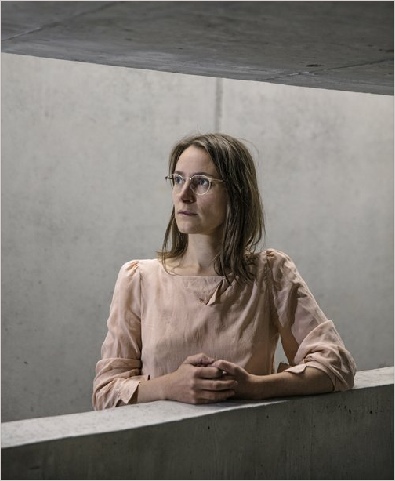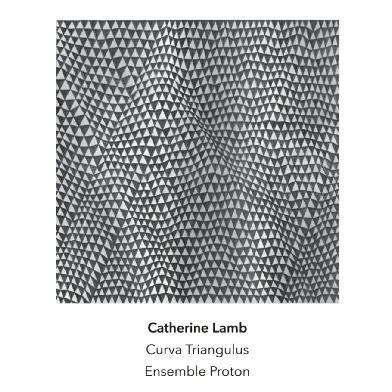Another Timbre TimHarrisonbre

at227 Catherine Lamb ‘Curva Triangulus’
Ensemble work for eight musicians, performed by Ensemble Proton, from Bern, Switzerland.
1 Curva Triangulus (2018/2021) 34:22
Ensemble Proton:
Bettina Berger - flute, alto flute Martin Bliggenstorfer - cor anglais, lupophone
Vera Schnider - triple harp Richard Haynes - clarinet d’amore, bass clarinet
Coco Schwarz - arciorgano Elise Jacoberger - bassoon, contraforte
Maximilian Haft - violin Jan-Filip Ťupa - violoncello
Notes on ‘Curva Triangulus’
The title was inspired by some recent works of Bridget Riley’s following an earlier thread -particularly from Tremor (1962), a plane of layered triangles warped by one directional sides of curved lines. I was interested in distinct and clear, contrapuntal points shaping the overall structure and their connected lines reverberating outwards - three points as triadic counterpoint, three points as harmonic extenders, and one line flowing freely from behind, adding curvatures to the air. I had just completed a series of pieces entitled Prisma Interius exploring the role of the basso continuo, via a custom digital filtering instrument of the live environment (a conceptual bridge between the focused harmonic space within the piece and the chaotic atmosphere surrounding it). I decided to extend this concept in Curva Triangulus with the role of the acoustic harp (Barberini triple harp) as a “free flowing agent” articulating / highlighting the progression of the clearer contrapuntal triadic material in the foreground. I was foraging somewhere between being a bad student of Zarlino (some fleeting moments of Marc Sabat’s Gioseffo Zarlino actually seem to appear…) as well as some kind of precursor to Rameau’s sounding body epiphany. I was imagining a late Renaissance position of musical perception, being warped by Riley’s triangles and shapes in multi-dimensional space.
I returned to the piece in winter 2020/21 with Ensemble Proton to re-examine their unique orchestration potentiality, such as incorporating Richard Haynes's clarinet d'amore and contrasting more distinctly between Elise Jacoberger's bassoon and contraforte. Vera Schnider (the harpist) and I examined more closely how to allow for her continuo role to blossom further, freeing it into a more intuitive, spiraling agent.
The biggest change was adding a part for Coco Schwarz on the historical Vincentino arciorgano organ, recreated and researched closely by both Johannes Walter and Johannes Keller. The instrumentation was already complex with the intermixing of various double reeds, winds, and strings - so I imagined how the organ could function as a kind of gentle, transparent glue to give more harmonic integrity. Its basis is to extend, smear, and bend those triangular shapes from within, as opposed to the role of the external and slightly romanticised, spiraling triple harp.
The harmonic space was configured numerically rather than alphabetically (like all of my work from the past 20 years), with consideration of distinct vibrancies when certain numbers intermingle and spectrally align. Curva Triangulus is an ever-fluctuating modal space -shifting between Tertial (3 prime qualitative), Quintal (5 prime qualitative), and Septimal (7 prime qualitative). Fundamental and branching nodes waver within each elongated, unfolding phrase.
The piece fits into a conglomerate of works where I have been exploring the various functional roles of each musician in moment form, always with the intention towards the total unity of the ensemble and what might emerge particularly from that unification in space. Elemental concepts around melody and harmony are reconsidered, blurred. One generates the other rather than being separate entities. The musician roles shift between being active generators and passive harmonisers, always in relation to one another. In the revised version, these roles are more evenly distributed amongst the ensemble, which adds more diversity in timbre and intentionality.
Catherine Lamb April 2024
Ensemble Proton normally consists of four woodwind and four stringed instruments, an octet with a clear symmetry and yet unfathomable versatility. In Curva Triangulus this duality is skewed by the omission of a piano and the integration of the arciorgano, a bellow-driven wind organ, whose sound supports the entire score. A triple harp - one of the many harps at the disposal of harpist Vera Schnider - accompanies, punctuates and links whole sections of the work. Alongside the ethereal, omnipresent string sounds of violin and violoncello, the quartet of woodwinds is augmented by auxiliary instruments - alto flute, cor anglais, lupophone, clarinet d’amore, bass clarinet and contraforte - entering darkly rich, sonorous terrain.
Richard Haynes, Ensemble Proton, April 2024

Catherine Lamb
